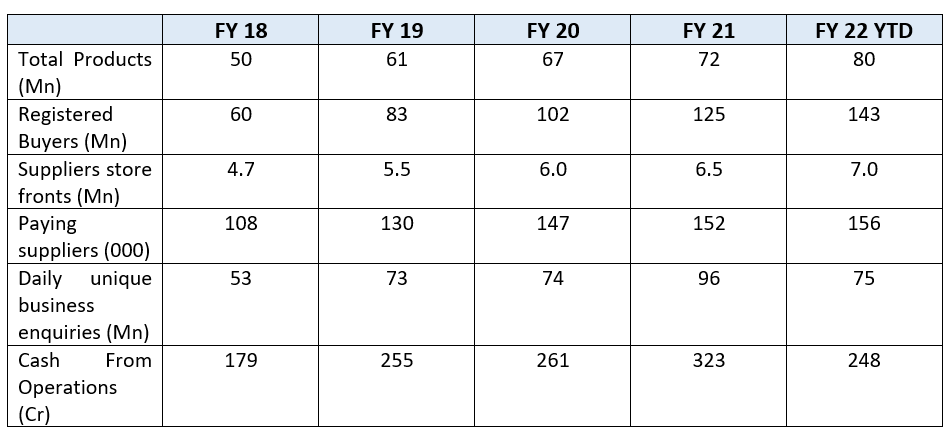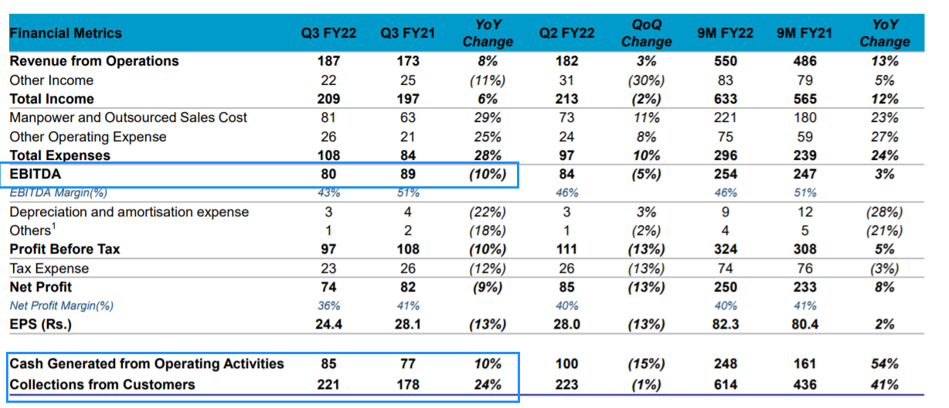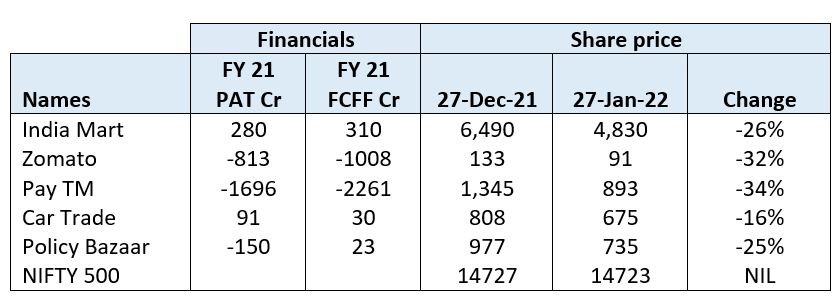Our Process For Exit Decisions (Part 2)
We have put together a brief note explaining how we take exit decisions.
Read MoreWe have put together a brief note explaining how we take exit decisions.
Read MoreA question we introspect on significantly is whether the next stage of value migration in Banking will be from Private Banks to Digital players.
Our working hypothesis at present: well-run Banks will grow aggregate profits; however, their valuations will drift downwards as ROEs will decline.
Read MoreSharpe ratio seeks to determine risk-adjusted returns, or “returns per unit of risk”. The higher the Sharpe ratio, the better the fund’s historical risk-adjusted-performance.
Solidarity’s Sharpe ratio since inception is ~2x that of the NIFTY. This implies for the same level of risk, we have delivered twice the return.
Read MoreWe have put together a brief note to discuss the importance of shutting out the noise and our process to do the same.
Read MoreEnclosed note contains our perspective on some commonly asked questions.
Read MoreCommentators are wondering why the Indian stock market is “shockingly resilient” amidst the devastation caused by the Covid second wave. Their premise is that Covid’s second wave is causing significant devastation and death. 2021 GDP growth has been downgraded. Rising raw material prices will erode margins. The virus has spread across the country and will cause massive unemployment. Analysts have started downgrading estimates. Stock price valuations are 2X of China. So why has the market fallen only 5% since February?
Read MoreIf one gets both legs of market timing—selling and re-entry—perfectly right, the net impact on incremental IRR versus staying invested is not significant, especially considering the probability of perfect timing is practically zero.1
We enclose calculations below:

Why is it that market timing seldom works?
Then why do people continue to be tempted by cash calls?
So how to protect against drawdowns?
At Solidarity, we firmly believe that trading and investing don’t mix as one has to train the brain to think long term during moments of stress and not freeze.
Please click here if you would like to download the PDF version of this blog
Enclosed note contains our perspective on some commonly asked questions.
Read MoreWe hold a position in India Mart whose price fell sharply since then by ~35% in the last two weeks.
In this note we explain
a) Our Investment thesis on the company
b) Our hypothesis on what could explain the decline
c) How we have acted post the steep decline
Investment thesis
India Mart is a B2B product and service listing platform that allows buyers to discover vendors for specific products & services. Suppliers are allowed free listing but pay a price to get more visibility and leads.
We find India Mart an attractive long term investment opportunity as
Long run-way of growth
India Mart customers are primarily SME. It has about 70 Lac “supplier fronts” on its platform of which 1.56 Lac are paying customers (balance are free-listings)
We believe the number of paying suppliers can continue to grow over time.
Average revenue per user
The average revenue per customer is ~48,000 today. We believe India Mart has significant pricing power which it can exercise once user growth slows to create win-win outcomes. For example 1688.com which enjoys ARPU of ~1.45 lacs has grown its top-line at 30% CAGR over 2015-20, primarily through price increases.
Significant competitive edge
The business model enjoys network effects as a virtuous cycle gets created. More buyer participation attracts more seller participation which in turn gets more buyers on the platform. Today 100% of buyer traffic is generated organically without advertisements. ~36% of suppliers on the platform are also buyers and 55% of buyers are repeat buyers.
The number of products, buyers, suppliers and transactions on India Mart’s platform has continued to increase resulting in increase in Cash Generated from Operations.

Not surprisingly, India Mart is the dominant market leader.
Attractive economic model
The business has about 80% contribution margin (Revenue less Customer Service costs) and hence has significant operating leverage and better productivity as over time Revenues will increase faster than Fixed costs. Moreover, Contribution margins should also expand over time as more technology is leveraged for automation. Hence we expect EBITDA margins to keep expanding over time by 1%+ per year even as Revenue can grow 20%+.
As suppliers pay in advance, India Mart operates on a negative working capital cycle and requires no fixed assets. Hence, incremental return on capital are very high with FCFF exceeding PAT as no significant re-investments in Fixed Assets required and all Technology expenses routed through the P&L Account.
Option value of adjacencies
We like to think of India Mart’s business definition as that of a “company enabling SMEs to compete in the digital age through enablement of commerce”. Hence, while its core offering is the product/service catalogue service, it can offer other products/services to SMEs over time. Hence, the average revenue per user can continue to grow non-linearly.
It has also recently acquired an accounting software company and continues to invest in start-ups in related service offerings that SMEs need. Its sales force can over time cross sell these products to suppliers registered on its website. This “Option value” can create growth over and above the 25% EBITDA growth we believe is achievable in the core business. While it is still early in the integration of acquisitions/investments to the core platform, progress on of the early investments, Vyapar, has been quite remarkable. Since Sept 2019 till date, paid users and monthly revenue run rate has increased from ~15k to 100k and 20 lacs to 1Cr+ respectively.

Conservative and disciplined management
The business has been built over 20 years with experimentation and discipline rather than the “fast burn” model one sees in new age Digital business models. All through the pandemic, the management has not talked up its prospects but talked about challenging business conditions. They have been very cautious in investments in adjacencies taking small stakes in companies, barring the recently announced 500 Cr acquisition.
Why has the stock price collapsed recently?
India Mart used to trade at about 2200/share pre the pandemic (about 2 years ago). It ran up to a peak of 9800/share in the last 2 years. It was trading at about 6800/share in mid-January and fell ~35% over the last 2 weeks.
The following reasons could have led to the price decline.

The pace of volume growth guided by management was too low relative to expectations. The management guided for about 6000 new customers per quarter, which implies ~15% volume growth. This was perhaps not exciting enough for the markets that have expected much faster Digital adoption by SMEs. This growth is reasonable in our view given the SME sector would be hurting due to lockdowns and the company has enormous pricing power once SMEs can experience what the company has to offer. Longevity of growth and pricing power is being underappreciated.
Correlated sell off in Internet names. Almost all recently listed Digital business models in in India are loss making. These companies have sold-off recently (chart below shows 1 month price movement) and one wonders whether India Mart has also been collateral damage of a sectoral sell off despite being solidly profitable and cash generating

Solidarity stance
A sharp price decline always triggers an immediate re-examination of facts to ensure there is no new information that requires us to revisit our thesis. Based on what we know at present, the Investment case for India Mart has not changed.
We take rolling 5-year views. The ability to not worry about optimising short term outcomes helps us to take advantage of price dislocations. A sharp sell-off does not change our conviction as there are people out there operating with different time horizons, objectives and compulsions.
We typically hesitate from paying up over 50x PE ratios for any company as when you pay such high multiples, there is always the risk of “unknown unknowns” which you cannot eliminate. However, we believe a 50x Free Cash Flow multiple for India Mart is justified if it can grow bottom-line at over 25% for a decade (user growth, ARPU growth, operating leverage) and has a significant and expanding competitive edge with option value for growth in adjacencies. With Infinite Return on Invested Capital in the core business, it generates significant cash flow requiring no re-investment.
We had first bought India Mart two years ago and had trimmed some of our position on the way up when we felt valuations were euphoric. We had started buying India Mart on the way down for new accounts.
We have hence used this opportunity to add to our positions in accounts where we have cash.
Please click here if you would like to download the PDF version of this blog
Read MoreOver the last few years, traditionally defined “Value” stocks have continued to get cheaper while “Growth” oriented cos have done very well. The divergence is stark and is now prompting questions whether Value Investing is dead.
The categorization of stocks between “Growth” and “Value” is erroneous. Anything that is low PE multiple and out of favour with markets is typically labelled “Value” and anything with high multiples and fast growth is labelled “Growth”.
Read More